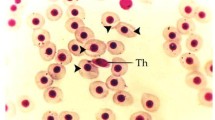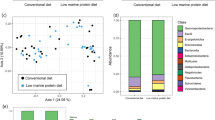Abstract
Triplicate groups of 40 Japanese seabass Lateolabrax japonicus (initial weight, 11.3 ± 0.4 g) reared in seawater (salinity, 30.0–33.0 g L−1) were fed with five isonitrogenous (41.3 ± 0.2% crude protein) and isoenergetic (18.5 ± 0.3 MJ kg−1) experimental diets formulated with increasing lipid levels (4.3, 8.4, 12.2, 15.8 and 20.1% lipid) for 10 weeks. Survival throughout the feeding experiment ranged from 87.5 to 100%, but the survival of fingerlings fed with the 4.3% lipid diet was significantly lower than the rest of the diets. At the end of the feeding experiment, fish fed with 12.2% lipid diet showed optimal growth performance (P < 0.05). Lipid contents of whole body, liver and muscle increased in parallel with the increase in dietary lipid levels. Viscerosomatic index (VSI), hepatosomatic index (HSI) and muscle lipid content were higher in 20.1% lipid group than those in the rest of the lipid level groups indicating that viscera and muscle tissues played important contributions to body lipid deposition. High proportions of 18:1n-9, eicosapentaenoic acid (20:5n-3; EPA) and docosahexaenoic acid (22:6n-3; DHA), and low concentrations of n-6 polyunsaturated fatty acids (PUFAs) occurring in liver and muscle, to some extent, reflected fatty acid (FAs) composition in the experimental diets.
Similar content being viewed by others
References
Ai QH, Mai KS, Li HT, Zhang CX, Zhang L, Duan QY, Tan BP, Xu W, Ma H, Zhang W, Liufu ZG (2004) The effects of dietary protein to energy ratios on growth and body composition of Japanese seabass (Lateolabrax japonicus). Aquacultue 230:509–516
Ai QH, Mai KS, Zhang WB, Xu W, Tan BP, Zhang CX, Li HT (2007) Effects of exogenous enzymes (phytase, non-starch polysaccharide enzyme) in diets on growth, feed utilization, nitrogen and phosphorus excretion of Japanese seabass (Lateolabrax japonicus). Comp Biochem Physiol 147A:502–508
AOAC (1996) Official methods of analysis of the association of official analytical chemists. Association of Official Analytical Chemists, Arlington
Du ZY, Liu YJ, Zhen WH, Tian LX, Liang GY (2002) The effects of three oil sources and two anti-fat liver factors on the growth, nutrient composition and serum biochemistry indexes of Japanese seabass (Lateolabrax japonicus). J Fish China 26:542–550 (In Chinese with English abstract)
Ellis SC, Reich RC (1991) Effects of dietary lipid and carbohydrate level on growth and body composition of juvenile red drum (Scienops ocellatus). Aquaculture 97:383–394
Folch J, Lees M, Sloanne-Stanley GH (1957) A simple method for the isolation and purification of total lipids from animal tissues. J Biol Chem 226:497–509
Gao C, Liu Q, Liang Y, Han A (1998) The optimum content of protein and fat in the artificial diet fed to cultured juvenile seabass (Lateolabrax japonicus). Mar Fish Res 19:81–85 (In Chinese with English abstract)
Hansen JO, Berge GM, Hiliestad M, Krogdahl A, Galloway TF, Holm H, Holm J, Ruyter B (2008) Apparent digestion and apparent retention of lipid and fatty acids in Atlantic cod (Gadus morhua) fed increasing dietary lipid levels. Aquaculture 284:159–166
Hardy RW, Scott TM, Harrell LW (1987) Replacement of herring oil with menhaden oil, soybean oil, or tallow in the diets of Atlantic salmon raised in marine net-pens. Aquaculture 65:267–277
Hemre GI, Sandnes K (1999) Effect of dietary lipid level on muscle composition in Atlantic salmon (Salmo salar). Aquac Nutr 5:9–16
HMSO UK (1994) Nutritional aspects of cardiovascular disease (report on health and social subjects No. 46). HMSO, London
Li AJ (1996) Feed and nutrition of aquatic animals. Agricultural Press, Beijing, pp. 199–200 (in Chinese)
López LM, Durazo E, Viana MT, Drawbridge M, Bureau DP (2009) Effect of dietary lipid levels on performance, body composition and fatty acid profile of juvenile white seabass (Atractoscion nobilis). Aquaculture 289:101–105
Mai KS, Zhang L, Ai QH, Duan QY, Zhang CX, Li HT, Wan JL, Liufu ZG (2006) Dietary lysine requirement of juvenile Japanese seabass (Lateolabrax japonicus). Aquaculture 258:535–542
Martins DA, Valente LMP, Lall SP (2007) Effects of dietary lipid level on growth and lipid utilization by juvenile Atlantic halibut (Hippoglossus hippoglossus. L.). Aquaculture 263:150–158
Metcalfe LD, Schmitz AA, Pelka JR (1966) Rapid preparation of fatty acids esters from lipids for gas chromatographic analysis. Anal Chem 38:524–535
Molnár T, Szabó A, Szabó G, Szabó C, Hancz C (2006) Effect of different dietary fat content and fat type on the growth and body composition of intensively reared pikeperch (Sander lucioperca L.). Aquac Nutr 12:173–182
Nanton DA, Lall SP, McNiven MA (2001) Effects of dietary lipid level on liver and muscle lipid deposition in juvenile haddock (Melanogrammus aeglefinus). Aquac Res 32(Suppl 1):225–234
Nortvedt R, Tuene S (1998) Body composition and sensory assessment of three weight groups of Atlantic halibut (Hipoglossus hippoglossus) fed three pellet sizes and three dietary fat levels. Aquaculture 161:295–312
Otwell WS, Rickards LW (1981) Cultured and wild American eels (Anguilla. rosfrata): fat content and fatty acid composition. Aquaculture 26:67–76
Pan Y, Wang FQ, Liu HL (2000) Optimal proportion of fish meal and soybean cake in formulated diets of juvenile sea perch (Lateolabrax japonicus). J Dalian Fish Univ 15:157–163 (In Chinese with English abstract)
Sargent J, Tocher DR, Bell JG (2002) The lipids. In: Halver JE, Hardy RW (eds) Fish nutrition, 3rd edn. Academic Press, San Diego, pp 181–257
Sheridan MA (1988) Lipid dynamics in fish: aspects of absorption, transportation, deposition and mobilization. Comp Biochem Physiol 90B:679–690
Snedecor GW, Cochran WG (1978) Statistical methods, 6th edn. Iowa State University Press, Ames
Tocher DR (2003) Metabolism and functions of lipids and fatty acids in teleost fish. Rev Fish Sci 11:107–184
Vergara JM, Robaina L, Izquierdo MS, De la Higuera M (1996) Protein sparing effect of lipids in the diets for fingerlings of gilthead seabream. Fish Sci 62:624–628
Wang JT, Liu YJ, Tian LX, Mai KS, Du ZY, Wang Y, Yang HJ (2005) Effect of dietary lipid level on growth performance, lipid deposition, hepatic lipogenesis in juvenile cobia (Rachycentron canadum). Aquaculture 249:439–447
Xue M, Lou L, Wu XF, Ren ZL, Gao P, Yu Y, Pear G (2006) Effects of six alternative lipid sources on growth and tissue fatty acid composition in Japanese seabass (Lateolabrax japonicus). Aquaculture 260:206–214
Acknowledgments
This work was supported by grants from Opened Funds of Jiangsu Key Laboratory of Marine Biotechnology, Huaihai Institute of Technology (2007HS001) and Doctoral Cooperation Funds between Universities and Enterprises of Jiang Su Province (BK2009652).
Author information
Authors and Affiliations
Corresponding author
Rights and permissions
About this article
Cite this article
Xu, JH., Qin, J., Yan, BL. et al. Effects of dietary lipid levels on growth performance, feed utilization and fatty acid composition of juvenile Japanese seabass (Lateolabrax japonicus) reared in seawater. Aquacult Int 19, 79–89 (2011). https://doi.org/10.1007/s10499-010-9342-7
Received:
Accepted:
Published:
Issue Date:
DOI: https://doi.org/10.1007/s10499-010-9342-7




